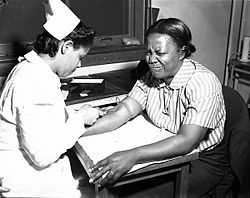热门问题
时间线
聊天
视角
疼痛
一种与组织损伤或潜在组织损伤相关的感觉、情感、认知和社会维度的痛苦体验 来自维基百科,自由的百科全书
Remove ads
身体的疼痛(pain)是由疾病、创伤、外在伤害性刺激,伴随现有的或潜在的组织损伤,所引起在知觉上或情绪上难受的、不愉快的感觉。疼痛是主观性的,影响的范围可为身体局部或整体,属一种复杂的生理、心理活动。
出于临床研究的需要,国际疼痛研究国际疼痛研究协会将疼痛定义为“由真正存在或潜在的身体组织损伤所引起的不舒服知觉和心理感觉”。[1][2]
疼痛是主观的感觉,早于1968年疼痛处理专家马戈·麦加费利首次提出一个在护理学界普遍使用的定义:“一个人说感到痛,这就是痛;他说痛仍在,痛就仍在。”(原文:Pain is whatever the experiencing person says it is, existing whenever he says it does.)[3][4]
身体疼痛是看医生的主要原因;在美国,有一半看医生的人是因为疼痛,是最普遍的原因。[5]疼痛也是大部分病患的征状,可根据维持时间、强度、种类(如火烧、针刺感等)、位置等来诊断。通常疼痛会自然消退,或通过简单的止痛处理后消退,这可称作“急性”疼痛。但有时疼痛本身已是一种病患,如慢性疼痛。近年痛症引起了不同学科专家的关注,如药理学、神经生物学、护理学、物理治疗和心理学,并形成了疼痛管理这门在麻醉学、物理治疗、神经学、精神科等专科之下的附属专科[6]。
Remove ads
用语区分
汉语中,痛与疼是近义词;在语意上,痛的含义较广泛,痛包含疼,且痛大于疼。“痛”较偏向慢性的、长久持续的、深入的、钝挫的疼痛。“疼”则较偏向急性的、短暂间断的、浅表的、热灼的、开放发散的、尖锐的疼痛[7]。
身体的“疼痛”,是主观、有意识的感觉。而“痛觉”,则指感受器、周围神经系统、脊髓和脑受有害刺激而引起的无意识活动[8]。一般而言,酸、痛、乏的症状与肌肉、软组织损伤较有关,而麻、抽、胀的感受则多和神经病变较相关;神经痛及神经性疼痛则为例外情形。
分类
痛觉感受器受到化学、热力或撞击等可损伤身体组织的刺激就可能会产生疼痛。若神经系统由病患或损伤而受损,可引致神经痛症或神经性病变痛症[9]。由感受器受刺激和神经系统受损引起的疼痛是两大主要疼痛发生机制,第三类是精神性疼痛,较为罕见。
其中,痛觉感受器引起的疼痛可细分为三种:[10]
疼痛与疾病
疼痛是许多疾病的常见或主要症状,如脑肿瘤的头痛、冠心病发作时的胸痛,胆石症的胆绞痛和腹痛、晚期癌症患者的癌性疼痛等。有些疼痛本身就是一种疾病,如带状疱疹的神经痛、三叉神经痛。疼痛不仅给患者带来痛苦,而且还对人体中枢神经、循环、呼吸、内分泌、消化和自主神经等系统造成不良影响,甚至是某些严重的、威胁生命的疾病症状。[11]
参见
注释和参考
外部链接
Wikiwand - on
Seamless Wikipedia browsing. On steroids.
Remove ads

